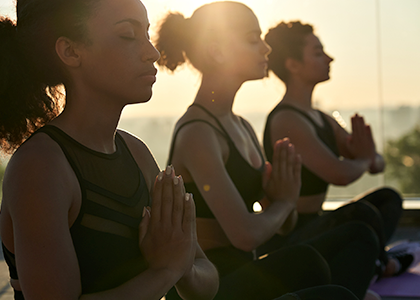
6 Steps to Calm Down & Live More Mindfully
By Suzanne Boothby
There’s a great saying that goes, “The time to relax is when you don’t have time for it.” Today, Americans and people throughout the world are more stressed out than ever. Our bodies can handle some stress from time to time, but a chronic state of stress is not healthy for anyone.
When you are amid a stressful week at work, having tensions at home or just feeling overwhelmed by your never-ending to-do list, it can be hard to calm down and live in the moment.
In Fully Charged: 7 Keys to Losing Weight, Staying Healthy and Thriving, Joe Cross writes, “Mindfulness, and the ability to relax that mindfulness gives you, is a vital tool in sustaining a healthy life.”
Mindfulness is a state of calm awareness. It’s learning how to pay attention to the present moment, making it virtually impossible to worry about anything else.
And it’s catching on. Research has found that mindfulness practices in schools can benefit both teachers and students. Studies have also found that it really does help easy anxiety.
While you can certainly cultivate a formal mindfulness practice or try using an app like Headspace or Calm, you can also try these six simple ways to calm down and bring more awareness into each day.
1. Deep Belly Breathing
When you pay attention to your breathing, you take your mind off your thoughts, according to acupuncturist and spiritual counselor Abdi Assadi. You may not even realize how shallow your breath is for most of the day. Abdi advocates for breathing from the abdomen, which helps open the lower sections of our lungs, replicating how we sleep at night.
You can start by simply setting aside 10 minutes a day to just focus on breathing from your abdomen and see for yourself if you feel calmer. You can try Abdi’s technique—head slightly down, tongue at the top of the teeth/bottom of the gums, index fingers pointing down, slightly up on the toes, breathing in and out through the nose ten times. Get more tips from him in this interview with Joe.
2. Walk, Run, or Move Your Body
Studies have found that movement and mindfulness go together. Runners often talk about the Zen-like feelings that come after a long run. And most people say they feel calmer even after a short walk around the block. But what’s more is that researchers have found specifically that walking in green spaces—outside areas with trees and plants—can lessen brain fatigue.
Other movements like qigong, an ancient Chinese practice that combines movement, breathwork, visualizations and meditation to help improve the flow of “qi” or life force in the body, or yoga, which brings together stretching and strengthening poses, breathing exercises and meditation practices, can be mindful forms of movement with great benefits too. Check out this article for more tips on getting started with yoga.
3. Color!
Adult coloring books have been around since the 1960s, but they have really started trending in the last few years exactly because so many people are looking for a simple way to wind down. Plus, it’s fun! With a set of colored pencils and a coloring book, you can easily unplug from your life and be present with an art project without needing years of art school. Preliminary research shows that engaging in an art project can help reduce stress.
4. Become a Single-Tasker
Almost everyone knows the perils of multi-tasking. While checking emails on your phone, you decide to make some tea and get the kettle going, then your dog barks and you remember to feed him and then you realize you need to put away your laundry and suddenly, the kettle is screaming. Multi-tasking isn’t just bad for your kitchen pots, it can increase your body’s production of stress hormones, such as cortisol and adrenalin.
Instead try single-tasking. Do one task at a time with no distractions. It’s better for your brain and better for your stress levels too.
5. Make Your Own Face Mask
Everyone feels more relaxed at a spa, but you may not have the time or budget to book an appointment on a regular basis. You can still reap the benefits at home by making your own face mask. Try this recipe for a Simple Soothing Banana Face Mask. You will need a few minutes to assemble the ingredients and then take at least 10 minutes to enjoy the mask on your face. You can put on your robe, play relaxing music and just let yourself unwind.
6. Put Yourself in Airplane Mode
If you are someone who has trouble falling asleep at night, consider powering your electronics down at least an hour before bed. If you travel a lot, you are familiar with airplane mode for your electronic devices. Even at home this simple feature allows you to use your phone or device without WiFi or cellular connections, meaning you won’t be able to receive texts, calls, emails or browse the Internet.
Excessive technology and social media use have created more stress, according to research from the American Psychological Association. The term used most often is the “constant checker”—someone who checks their email, texts, and social media accounts on a constant basis. Sound familiar?
Experiment with going into airplane mode at night or at any point in the day when you may want to focus on a project or relax without all the bells and buzz from your devices. Research has found that spending time on your smart devices has a negative impact on your sleep quality. We all know that a good night’s sleep is a vital way to recharge, so consider airplane mode to help you rest better.